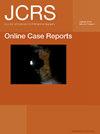Interrupted femtosecond laser delivery secondary to face mask–related fogging
Q4 Medicine
引用次数: 0
Abstract
Introduction: An increase in face mask utilization has been noted during the COVID-19 pandemic. A rare complication of keratorefractive surgery where interruption of femtosecond-laser delivery was noted secondary to face-mask related fogging of the patient interface is reported. Patient and clinical findings: Young patients with stable tear film and healthy ocular surface were advised femtosecond laser assisted laser in situ keratomileusis (3 eyes) and small-incision lenticule extraction (1 eye) for refractive errors. Intraoperative interruption of laser delivery was noted secondary to droplet condensation or fogging of the patient interface. The fogging developed secondary to the escape of humid exhaled breath. Diagnosis, intervention, and outcomes: Incomplete delivery of the laser required aborting the procedure with retreatment at a later date. In eyes where partial laser delivery was obtained, the flap was manually dissected from the underlying stroma and the procedure was completed in the same sitting. All eyes achieved a final uncorrected distance visual acuity of 20/20 with no long-term sequelae. Conclusions: Fogging of the patient interface is a rare complication secondary to face mask use. Sealing the top of the face mask with well-adhering micropore, readjustment of face masks, removing the mask prior to draping, and checking for droplet condensates on the interface prior to laser delivery may minimize the incidence.中断飞秒激光传送次要面罩相关的雾
导语:在2019冠状病毒病大流行期间,人们注意到口罩使用率有所增加。本文报道了角膜屈光手术中一种罕见的并发症,其中飞秒激光传输中断是由面罩引起的患者界面雾化引起的。患者及临床表现:年轻患者泪膜稳定,眼表健康,建议采用飞秒激光辅助激光原位角膜磨砂术(3眼)和小切口晶状体摘除(1眼)治疗屈光不正。术中激光输送中断是继发于液滴冷凝或患者界面雾化。雾的形成是由呼出的湿气逸出引起的。诊断,干预和结果:不完全的激光传输需要在以后的日期再治疗的过程中流产。在获得部分激光传输的眼睛中,手动从底层基质中剥离皮瓣,并在同一位置完成手术。所有眼睛最终未矫正的距离视力达到20/20,无长期后遗症。结论:患者界面雾化是一种罕见的继发于口罩的并发症。用黏附良好的微孔密封口罩顶部,调整口罩,在悬垂前取下口罩,在激光输送前检查界面上的液滴冷凝物,可以最大限度地减少发病率。
本文章由计算机程序翻译,如有差异,请以英文原文为准。
求助全文
约1分钟内获得全文
求助全文

 求助内容:
求助内容: 应助结果提醒方式:
应助结果提醒方式:


